Sarah Sundin's Blog, page 477
May 16, 2012
Today in World War II History
70 Years Ago—May 16, 1942: Allies complete withdrawal from Burma into India. New song in Top Ten: “Sleepy Lagoon.”
Published on May 16, 2012 03:00
May 15, 2012
Today in World War II History
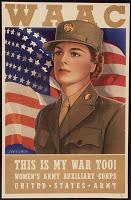 70 Years Ago—May 15, 1942: President Roosevelt signs legislation forming WAAC (Women’s Army Auxiliary Corps), under Mrs. Oveta Culp Hobby. Germans take Kerch in Crimea; Soviets flee peninsula, Sevastopol stands alone. US Army Air Force insignia changed to white star on dark blue disc; Pursuit units renamed Fighter units.
70 Years Ago—May 15, 1942: President Roosevelt signs legislation forming WAAC (Women’s Army Auxiliary Corps), under Mrs. Oveta Culp Hobby. Germans take Kerch in Crimea; Soviets flee peninsula, Sevastopol stands alone. US Army Air Force insignia changed to white star on dark blue disc; Pursuit units renamed Fighter units.
Published on May 15, 2012 03:00
May 14, 2012
The B-17 Flying Fortress, Part 1
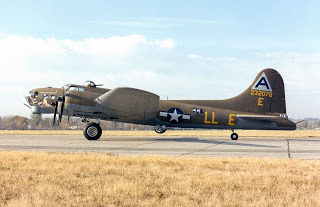 B-17 Shoo Shoo Baby of the US Air Force Museum, Dayton OH
B-17 Shoo Shoo Baby of the US Air Force Museum, Dayton OH(USAF Photo)Few World War II airplanes have captured the imagination like the Boeing B-17 Flying Fortress.
Springtime means the B-17s are on tour! Several organizations have beautifully restored B-17s that tour the country. For years, I've enjoyed walking through these planes, and last year I had the awesome privilege of flying in the Experimental Aircraft Association's Aluminum Overcast. You can read about my flight and watch a video here. If you'd like to see one of these gorgeous planes up close, please see the tour schedule for The Experimental Aircraft Association and The Collings Foundation.Over the next two weeks, I'll feature the legendary Flying Fortress - a starring side character in my novels. Today I'll talk about the plane and next week about the crew.
Development
In 1935, the US Army called for a multi-engine, long-range, high-altitude heavy bomber. On July 17, 1935, Boeing introduced Model 299, which made its maiden flight on July 28, exceeding Army specifications. With plenty of machine guns, it was dubbed the "Flying Fortress" by a reporter. Although Model 299 crashed on an early flight, Boeing received a contract to develop the YB-17 in 1936.
Improvements were made with each successive model - the B-17B in October 1939, the B-17C in July 1940, and the B-17D in February 1941. The C and D models were involved in America's entry into World War II - shot up on the ground in Hawaii and the Philippines and flying early bombing missions. Since a squadron of twelve B-17Ds was expected in Pearl Harbor early on December 7, 1941, when radar showed the approaching Japanese planes, the officer in charge dismissed the warning. Read the story here.
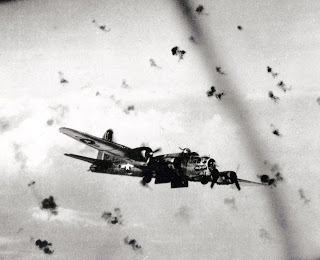 USAF PhotoCombat Models
USAF PhotoCombat ModelsThe B-17E rolled out in September 1941, the first model to sport the distinctive bell-shaped vertical stabilizer (tail fin). This model was used in the Eighth Air Force's first combat missions over Nazi-occupied Europe in late 1942. Further refinements led to the F model in August 1942. One of the most famous B-17Fs was the Memphis Belle, the first plane and crew to finish 25 missions in Europe.
Since no one expected dangerous head-on fighter attacks, the F model had weaker .30 caliber guns in the nose rather than the .50 caliber guns used in the rest of the plane. In addtion, the nose guns could not be trained to twelve o'clock. The Luftwaffe quickly discovered this deficiency and adopted head-on attacks with devastating results to the Eighth Air Force. Desperation and ingenuity led airmen to shatter holes in the nose of the plane and suspend a .50 caliber gun with racks and retractable cords. Later B-17Fs incorporated a factory-installed .50 caliber nose gun and eventually a chin turret with two .50 caliber guns.
The last and most common model, the B-17G, entered combat in September 1943, but further refinements were made throughout the war.
Specifications
With a wing span of 103 feet and a length of 74 feet, the B-17G cut a graceful figure. Powered by four Wright R-1820 Cyclone engines, it could carry a crew of ten and a bomb load of up to 8000 pounds (but less on long-distance missions). The B-17G had a top speed of 302 mph and a ceiling of 36,400 feet. Depending on the model and theater of operations, B-17s carried ten to thirteen machine guns.
The B-17 was the first plane to use turbo-superchargers, which boosted engine performance at high altitude. The plane also featured the Norden bombsight, a complicated piece of machinery that allowed the bombardier to compensate for airspeed, wind speed, and drift when bombing. Purported to drop a bomb in a pickle-barrel, the Norden never reached that accuracy in combat, but did allow successful high-altitude, daylight strategic bombing.
Published on May 14, 2012 05:00
Today in World War II History
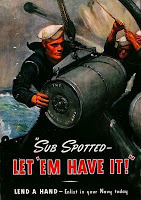 70 Years Ago—May 14, 1942: Australia decides to ration food and clothing. US Navy begins full convoys on east coast.
70 Years Ago—May 14, 1942: Australia decides to ration food and clothing. US Navy begins full convoys on east coast.
Published on May 14, 2012 03:00
May 13, 2012
Today in World War II History
70 Years Ago—May 13, 1942: US troops replace New Zealanders in Fiji, take responsibility for islands.
Published on May 13, 2012 03:00
May 12, 2012
Today in World War II History
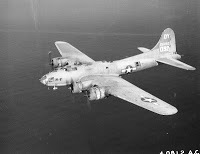 70 Years Ago—May 12, 1942: U-507 sinks US tanker Virginia at mouth of Mississippi River, 27 killed. Production begins of B-17F Flying Fortresses. San Francisco Bay Area has 25-minute air raid alert.
70 Years Ago—May 12, 1942: U-507 sinks US tanker Virginia at mouth of Mississippi River, 27 killed. Production begins of B-17F Flying Fortresses. San Francisco Bay Area has 25-minute air raid alert.
Published on May 12, 2012 03:00
May 11, 2012
Today in World War II History
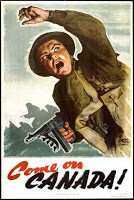 70 Years Ago—May 11, 1942: Canadian Parliament approves full conscription.US authorizes Air Medal, awarded retroactively to September, 1939.
70 Years Ago—May 11, 1942: Canadian Parliament approves full conscription.US authorizes Air Medal, awarded retroactively to September, 1939.
Published on May 11, 2012 03:00
May 10, 2012
Book Beat - Where Wildflowers Bloom
 Have you ever wanted to run away from your pain and find a new life? In
Where Wildflowers Bloom
by Ann Shorey, that's exactly what Faith Lindberg wants.
Have you ever wanted to run away from your pain and find a new life? In
Where Wildflowers Bloom
by Ann Shorey, that's exactly what Faith Lindberg wants.The Civil War has taken a high toll. Faith has lost her father and brother, and Royal Baxter, the man she gave her heart to, has failed to return. If only she can leave Noble Springs, Missouri and its painful memories for Oregon. However, her only remaining family member, her grandfather, has no desire to sell his mercantile and leave his home. Meanwhile, Rosemary Saxon and her brother Curt arrive in Noble Springs. Rosemary is running from the stigma of having served as a nurse, and Curt is running from his war memories. Faith finds a welcome friend in Rosemary, but Curt's hot-and-cold emotions flummox her. When Royal Baxter rides back into town, she finds herself torn between the two men - and finds her dream slipping away.
Ann Shorey has created a likeable heroine in Faith Lindberg - she's sweet and compassionate, but strong enough to stand up for what's right. Curt Saxon is an intriguing hero as he falls for Faith but keeps his distance while he wrestles with his "soldier's heart" - what we now call Post-Traumatic Stress Disorder. Ann Shorey's writing draws me right in, with lovely phrasing and plenty of humor. I highly recommend this novel, and I'm looking forward to the next two books in the Sisters of the Heart series.
Published on May 10, 2012 05:00
Today in World War II History
70 Years Ago—May 10, 1942: Japanese attack British forces at Shwegyin, Burma.
Published on May 10, 2012 03:00
May 9, 2012
Today in World War II History
70 Years Ago—May 9, 1942: First US troops arrive in Tonga Islands and Galapagos Islands. New song in Top Ten: “Jersey Bounce.”
Published on May 09, 2012 03:00



